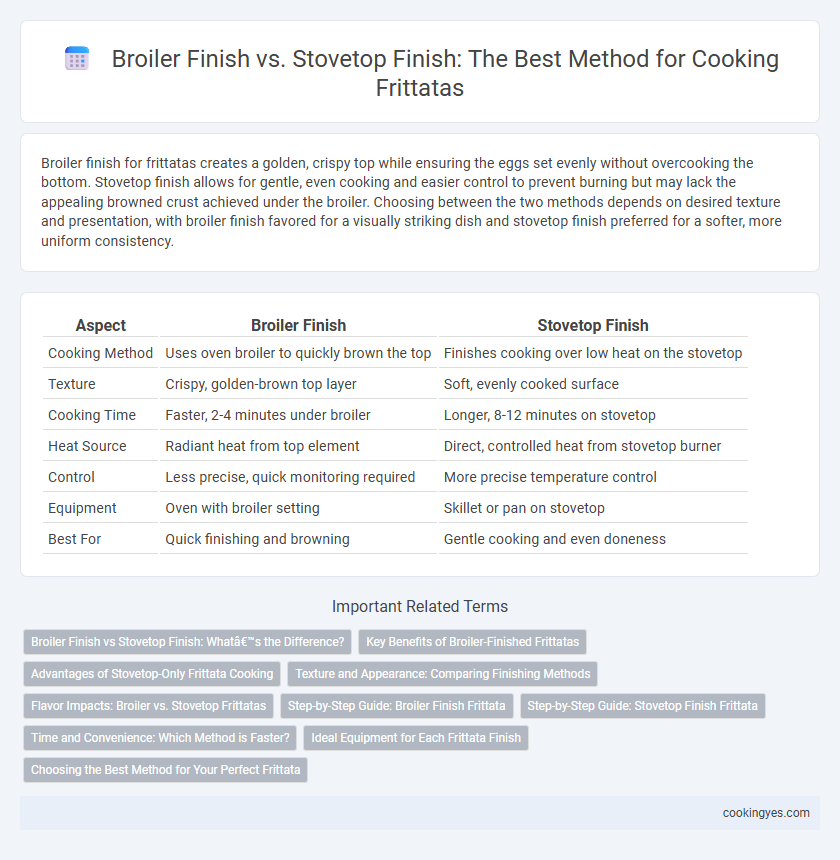Broiler finish for frittatas creates a golden, crispy top while ensuring the eggs set evenly without overcooking the bottom. Stovetop finish allows for gentle, even cooking and easier control to prevent burning but may lack the appealing browned crust achieved under the broiler. Choosing between the two methods depends on desired texture and presentation, with broiler finish favored for a visually striking dish and stovetop finish preferred for a softer, more uniform consistency.
Table of Comparison
| Aspect | Broiler Finish | Stovetop Finish |
|---|---|---|
| Cooking Method | Uses oven broiler to quickly brown the top | Finishes cooking over low heat on the stovetop |
| Texture | Crispy, golden-brown top layer | Soft, evenly cooked surface |
| Cooking Time | Faster, 2-4 minutes under broiler | Longer, 8-12 minutes on stovetop |
| Heat Source | Radiant heat from top element | Direct, controlled heat from stovetop burner |
| Control | Less precise, quick monitoring required | More precise temperature control |
| Equipment | Oven with broiler setting | Skillet or pan on stovetop |
| Best For | Quick finishing and browning | Gentle cooking and even doneness |
Broiler Finish vs Stovetop Finish: What’s the Difference?
Broiler finish for frittatas creates a golden, slightly crisp top by exposing the dish to direct high heat, ideal for achieving an evenly browned surface in minutes. Stovetop finish relies on gentle, even heat from below, allowing the frittata to cook through steadily but often results in a softer, less caramelized top. Choosing broiler finish enhances texture contrast and presentation, while stovetop finish maintains consistent cooking and a tender outcome.
Key Benefits of Broiler-Finished Frittatas
Broiler-finished frittatas develop a golden, crispy top layer that enhances texture and visual appeal, setting them apart from stovetop counterparts. This method allows for even cooking throughout while preserving the creamy interior, offering a perfect balance of softness and crunch. The high, direct heat from the broiler also efficiently melts cheese and caramelizes toppings, intensifying flavor and aroma.
Advantages of Stovetop-Only Frittata Cooking
Stovetop-only frittata cooking offers precise temperature control, reducing the risk of overcooking or burning compared to broiler finish methods. This technique ensures even heat distribution, promoting a uniformly creamy texture throughout the eggs. The stovetop approach also allows for seamless addition of mix-ins during cooking, enhancing flavor integration and customization.
Texture and Appearance: Comparing Finishing Methods
Broiler finish for frittatas creates a crisp, golden-brown top with a slightly charred texture, enhancing visual appeal and adding a contrast to the creamy interior. Stovetop finishing yields a uniformly soft surface without browning, maintaining a more delicate and moist texture throughout the dish. Choosing between broiler and stovetop finish depends on whether a crispy, browned top or a tender, smooth appearance is preferred.
Flavor Impacts: Broiler vs. Stovetop Frittatas
Broiler-finished frittatas develop a caramelized, slightly crispy top that enhances depth of flavor through Maillard reactions, creating a rich, savory crust. Stovetop-finished frittatas maintain a tender, uniform consistency, emphasizing the freshness of ingredients without the added smokiness or crunch. Choosing broiler finish intensifies umami notes, while stovetop finish preserves a delicate balance of egg and fillings.
Step-by-Step Guide: Broiler Finish Frittata
Broiler finish frittatas develop a beautifully browned, crisp top by transferring the partially cooked frittata directly under the broiler for 2-3 minutes. Begin by cooking eggs and fillings on the stovetop over medium heat until the edges set but the center remains slightly runny, then place the skillet in the broiler. Monitor closely to prevent burning, and remove once the surface is golden and fully set, resulting in a texture that balances creamy interior with a caramelized crust.
Step-by-Step Guide: Stovetop Finish Frittata
Cooking a frittata with a stovetop finish requires a precise step-by-step guide to ensure a creamy, evenly cooked dish without burning. Begin by sauteing vegetables and proteins in an oven-safe skillet over medium heat, then pour in whisked eggs mixed with cheese and seasonings. Reduce the heat to low, cover the skillet with a lid, and cook for 8-12 minutes until the eggs are set and the edges pull away from the pan before serving.
Time and Convenience: Which Method is Faster?
Broiler finish cooks a frittata rapidly, typically taking 2 to 4 minutes under high heat, offering quick browning and a crispy top with minimal supervision. Stovetop finish requires careful, lower-heat cooking for 10 to 15 minutes to set the eggs evenly, demanding more attention to prevent burning. For fastest results and convenience, broiler finish is the preferred method, especially when time efficiency is essential.
Ideal Equipment for Each Frittata Finish
Broiler finish for frittatas requires an oven-safe skillet or cast iron pan capable of withstanding high heat to achieve a golden, bubbly top without overcooking the interior. For stovetop finishes, a non-stick skillet with a tightly fitted lid is ideal to evenly cook the eggs through gentle heat and steam retention. Using the correct equipment enhances texture and flavor, ensuring a perfectly cooked frittata with either method.
Choosing the Best Method for Your Perfect Frittata
Choosing between broiler finish and stovetop finish for cooking frittatas depends on desired texture and convenience. Broiler finish creates a golden, slightly crispy top perfect for a visually appealing presentation, while stovetop finish offers a tender, evenly cooked surface with less risk of browning. Consider broiler finish for a restaurant-quality look and stovetop finish for a softly set, homestyle frittata.
Broiler Finish vs Stovetop Finish for Frittata Cooking Infographic

 cookingyes.com
cookingyes.com